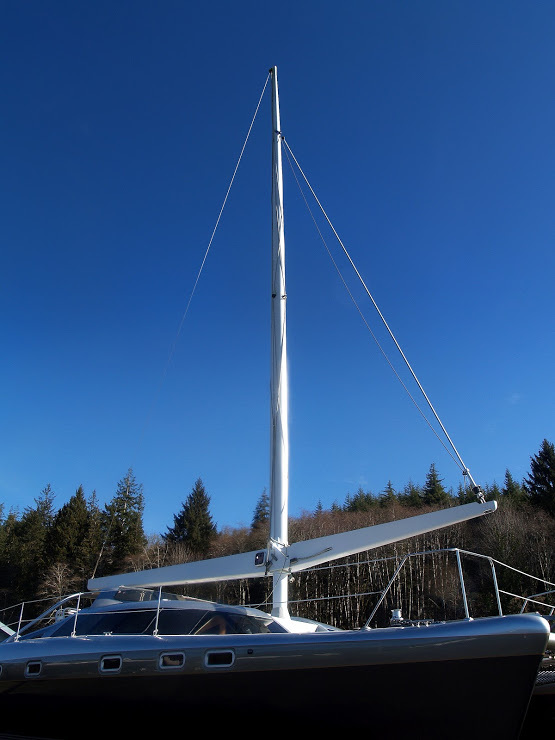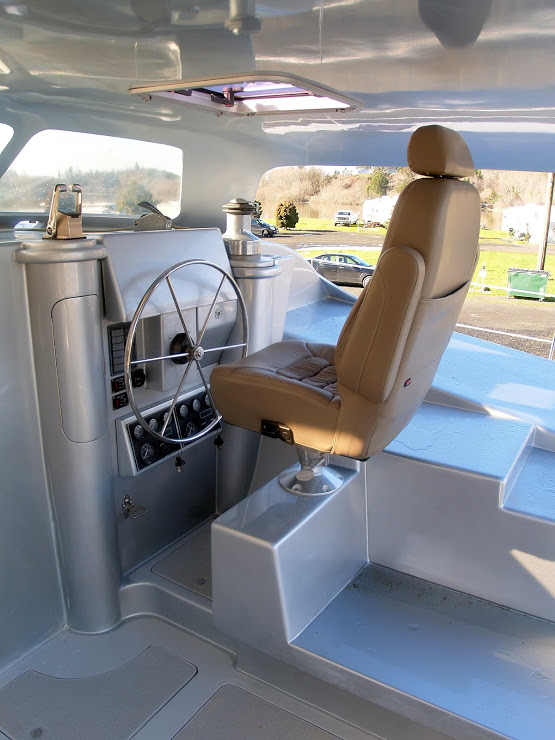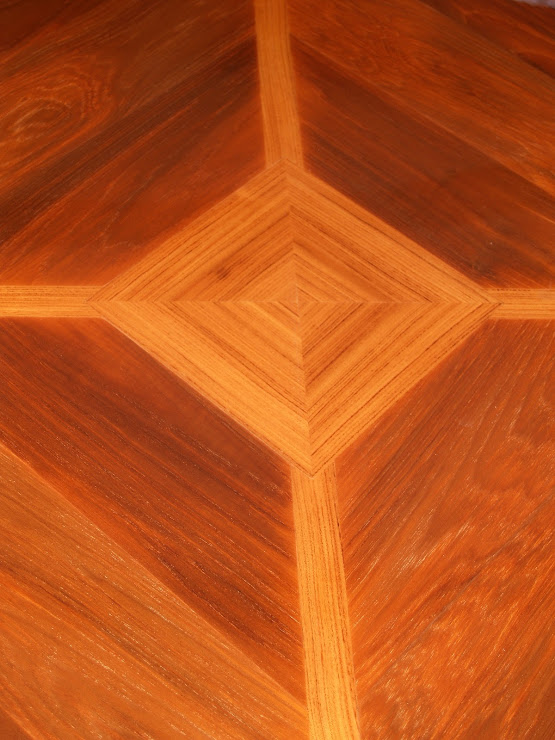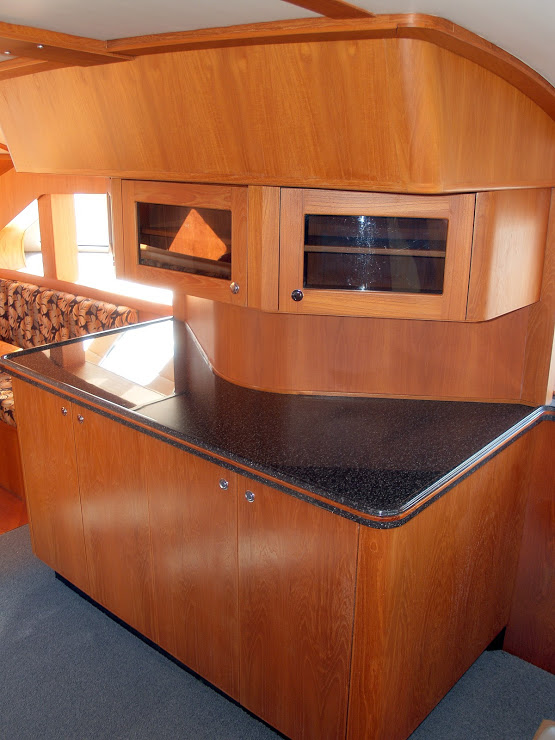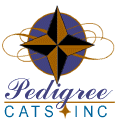Questions & Answers
Frequently Asked Questions
If you don’t find the answer you’re looking for, contact us!
info@pedigreecats.com
(360) 942-2810
How long does it take to build your dream?
Based on our first price estimate, a basic 60′ power or sail typically takes about 24 months. This would be a very nice Cat, but not a lot of fancy, expensive items on board (gold faucets etc.) Engines, hydraulic steering, electric heads, windlass, gen.set, etc., very nice, but not a lot of goodies. The second price we show is with almost everything clients really want onboard, Watermaker, A/C, Shore boat, TV (s), fancy wood decor and custom items and electronics. This, of course, also adds more time to construct, maybe 6 months, You can also have us build to a certain stage and you take her home and finish the build or stretch out the time to build to fit your schedule or investments. If you add 6 months to each of these times, it would be for a 75′-85′ and 6 months to that and you would be in the 100′ range.
Taking her home from here or maybe cruise the San Juan islands, inside passage to Alaska first. Clients have also taken them to Vancouver and had them shipped to Florida or hire a crew to deliver them to where they want.
Can I have what I want ?
Yes! 100% But you must stay in the boundaries of the designer structural requirements i.e.. mast placement, weight to be carried and where. All the multihulls we have built over the last 42 years, have been what the clients have wanted, inside and out. Once they find the size they think will work, we find the basic design and designer for their dream platform to create it.
The final look is up to you, either with your drawing or pictures or work with one of several concept artists we know to help. Same with the interior, your interior designer, pictures or cut out from magazine of things you would like or we can line you up with someone to help. You work directly with these people, pay them directly to go as far as you want or need to, the do not work for Pedigree.
Why does Pedigree Catamarans, Inc. post our prices online?
We have been building multihulls since 1975 and we know how many hours each boat should take to build, even custom boats since we do not build production boats. Other companies may not have built or built enough boats to determine the cost. Granted boat costs vary directly with the customer’s requirements, however the hull build should not vary much.
Also, we do not have “salesmen.” We are a owner/operated business that talks directly with each customer based on our 42 years of boating and cruising experience. We believe that you want a cat of your own, not what a production builder thinks everyone should have.
I would be very leery of a company who wants large deposits up front and can’t provide basic prices to a customer. What we are hearing now from people that have paid a large deposit up front, only find the builder wants more and more and exceeded their guess of the cost and time line. Then the worst, they want more money or they will sell the cat to someone else, holding it for ransom from the highest bidder, Our clients chose to pay as we build and the cat is 100% theirs from the start and definitely no large deposit up front.
Why do Production Cats depreciate so much more than a quality custom built cat?
Several reasons. One might be, that every cat produced is probably from the same mold and in most cases, several years old and not updated or no improvements incorporated over any previously produced. Thus no real reason to get a new one if you can get the same one used for a lot less. The owners must lower their asking price far enough below the new ones that it will make it desirable. The price on the same new cat, next year, must be in line pricewise, in the marketing field to be sold, thus last years model must be substantially lower.
The production cats do not provide the clients with what they expected in a catamaran. Lacking in performance, require a lot of power to move them at a reasonably expected speed, to narrow to give the stability and the room onboard they were led to believe they would have. Deeper draft than expected, very heavy solid fiberglass construction, noisy, sinkable, sweat and hard to maintain a comfortable temperature inside. Most are imported and can not be used for charter in US waters.
One of our custom built multihulls came up for sale, built in 1980 and sold for $60,000 more than it cost the owners to have it built back then.
Even today, we have people trying to buy the clients cat we are constructing from the client and at a substantial amount more than they have into their dream. Problem is, this is their dream and it is not up for sale.
Why is it so many catamaran builders that started building a few years back are no longer in business??
This question keeps coming up and I think one reason is because most of them wanted to build one female catamaran mold and hope everyone wanted what came out of it. Stamp them out and try to make their fortune. People now have the tools to research boats and builders and we highly recommend everyone do so. In 1994, about 50 builders surfaced, claiming to be the biggest and best. I think most are gone and their web sites no longer come up. Still some inquiries feel more comfort in the fact that these were to be “Proven Production cats”. Maybe one got built by the “Factory” but most didn’t, talk about the only “One Off” they built. This was the case since 1994 and probably before.
Who designed some of these offerings in these production Cats. One we know of was a Monohulls cut in two and widened, with half hulls vertically mounted panels on the inboard side to plug the hole. Heavy, deep draft, didn’t make it as a monohull and will never make it as a good cat. Others are from molds made years ago that were for sailing cats.
Don’t get me wrong, PDQ gets my vote as a production built cat. I send referrals to them weekly, a great cat, one most can afford for the type cruising they do. Their new larger power cat will be as great a buy as the littler ones have been and with all the experience behind them.
We are not claiming to be the world greatest, biggest, the leader or any of the sales pitches some use. We do use only proven, name brand materials and proven multihull designers. We do build exactly what the clients want and with very high standards. They are the best and most experienced in their field of designing multihulls, not a monohull designer that would draw anything for a buck. We do insist the clients get their own independent “Marine Surveyor” to monitor the building process as most clients do not have the experience to know if she’s being built properly.
Pedigree Catamarans, Inc. has been building catamarans in the Pacific Northwest for over 19 years and Gary Habersetzer has been building multihulls on the West Coast since 1975. “In my thirty nine years of building composite multihulls, I have never built the same one twice, they have all been as different as all my clients.”
The era of production boats is loosing it popularity, one size does not fit all. Today’s clients want their yacht to look like they want it to, thus our stylists are available to help there. Custom Yachts give you exactly what you have in mind, inside and out.
Building your dream is a big investment. When carefully done by the right builder using the right materials, the experience can be fun and rewarding.
Be careful, do your research, this is fun and very rewarding if done right. She’ll have good resale value as replacement value goes up annually. The biggest thing is that you have what you want, not what a struggling production builder thinks everyone should have and furnished with what he thinks you need. Also be aware, the imported cats also have a smaller market when they are sold, they can not be used in US waters for charter, “The Jones Act” Salesmen never will tell you that, but the info is out there and makes a great difference when it comes time to sell your dream.
CAT OR TRI?
Taken from The Design File, Tony Grainger Yacht Design.
“CATS have become more popular for cruising mainly because of the accommodation space and privacy they provide and because for a given length they are faster and cheaper to build than a trimaran. TRIS, on the other hand, provide good performance through a wider range of conditions than catamarans, and can also be effective for cruising by utilizing flare above the waterline in the main hull, and by fitting aft cabins where additional privacy is required in the accommodation layout. Apart from the accommodation, the trimaran provides a more forgiving motion in a sea way and better resistance to pitching if the hull shapes are well designed, and the wide beam allows it to carry more sail in fresh conditions. Against these advantages is the fact that a cat will require less berthing space and is likely to be more maneuverable in close quarters if twin diesels are fitted. Also, the cat will have a more steady motion than a tri while sailing downwind.”
I built my first multihull in the 70’s and it was a Trimaran, foam cored, TriStar design, a great multihull. Now I am building a cat for my wife and I, mainly because of the room, very wide main salon and stateroom and big aft deck and flybridge. The Tri was maybe a bit more sea kindly than the cat will be, but besides not having to build a third hull, she will be a bit faster as well as maybe a bit more economical.
How much does a custom catamaran cost?
The cost of a custom Pedigree catamaran, constructed with foam core, composite construction is very close to that of a production built yacht. The advantage is, you will have exactly what you want and the disadvantage is, it will take a little while to build.
Charter cats are generally a lot less expensive. They do not need the big ticket luxury items, such as water makers, A/C, big gen. sets, fancy interiors, etc.
When we have an opening to start a new project, you can have just the hulls built and finish the catamaran yourself at a considerable savings at your home port. If you wish, we can provide you with a cat at what ever stage you like. For example, we can fit the engines and aide in completion and when you are ready to launch, we can arrange that as well.
Most of our catamarans are fully loaded and ready for cruising. We have listed the average cost clients have spent on our amenities and pricing page. For a list of some of amenities included in a Pedigree Cat and the average prices, click on the “Amenities & Pricing” button available from most pages on our site.
Over the last 20 years, the clients have chosen to pay as we build and they have approved to have done as well as what we purchase for them, engines etc..
All and all, we can provide just about anything you and your budget can imagine. Our goal is to get you out there to enjoy the fun with the exact Catamaran you have always wanted.
I think we are about the only builder that shows you the price you might spend on you dream, it’s up to you and what you want and need.
O.K. - I am interested in a Catamaran. What do I do next?
Step 1 – What type and length do I need?
Step 2 – What is included and how much is it going to cost?
Step 3 – Contact Us
Why foam core?
Foam core has several advantages: no deterioration, insulated, virtually unsinkable and stronger than solid fiberglass and Aluminum when tested in the same manner.
Foam core sandwich construction is the most technologically advanced form used in construction today, especially in conjunction with E-glass, Kevlar, Carbon Fiber and Structural foams. Structural foams are classified as load carrying, closed cell plastic foams that are non friable (will not readily crumble when stressed). Each designer calls for the materials to be used in the building process, including foam, fabric and resin. Pedigree Catamarans specializes in foam core construction only. The foam used in the hulls, bridgedeck and bulkheads of our catamarans is generally Airex® R63 because of its high impact specifications. This foam is a resilient, thermoformable linear linked, PVC foam core material with exceptional slamming load dissipation characteristics. Divinycell H foam, a Polymer foam is used above the bridgedeck. Other specified foams may be used as the designer specifies.
Clients have realized that their multihull has gone up in value over the years, because of the foam core material and because of the replacement cost. Airex® foam core and sandwich construction produces a catamaran that is 35 times stronger than solid fiberglass, wood or aluminum according to Airex manufactures. It is also is about 30 percent lighter; will not rot or corrode; does not sweat and provides floatation that makes the catamaran virtually unsinkable (yes, everything can sink if put enough weight on it.)
What is displacement?
Displacement is how much the boat weighs and is the weight of sea water she will displace when floating. Foam core construction is about 30% lighter than solid fiberglass, Aluminum according to foam core manufactures. When the designers use the term “full displacement”, it usually means the vessel is cruise-ready with equipment and fuel or with the “useful load” on board. While “light displacement” means empty and where it doesn’t even have fuel on board. Lighter construction allows more payload to be carried and smaller engines to reach a good cruise speed, which uses less fuel, allows greater speeds, shallow draft, etc..
This is something to look at when you start comparing cats, there weight. Our 50′ cats weight in at an average of 15,000 lbs. empty and draw about 30″ (rudder and props are the deepest.) Where most production cats are up closer to 50,000 lbs., deeper draft, more HP to get them up to an acceptable speed, must carry more fuel to get her up there as well as the bigger engines. The designers we use have displacement hulls, about 18 to 21 knot range of speed with reasonable HP and fuel consumption.
What about Range?
A little about under power….as under sail with a little wind, you are unlimited. The engine manuals usually have a chart, but a common method to get an idea of range is to divide 20 into the horsepower of each engine. This will give you an idea of GPH you would burn at the higher continuous RPM per engine. I have found that for each cylinder at idle burns about 1 quart of fuel…so 6 cylinders is about 1.5 GPH at just above idle or 1,000 RPM achieving hull speed on a calm day.
A cat on a calm day can reach hull speed with one engine at just above idle. Hull speed in knots is figured by taking 1.34 multiplied by square root of the water line length of your cat. Lets use about 10 knots or 11-12 mph and that will give you some idea. I like to put enough fuel onboard to have about a 1,000 mile range at cruise speed (rpm) say somewhere about 15 mph and this usually takes both engines to do that, but not wide open. From California to Hawaii (non-stop) close to hull speed, that is where you have the best range and least resistance, even better, motor sailing. That range will also get you to the next fuel dock or allow you to pass up the island that just got their fuel they have waited 6 months for and will cost you a lot to take it away from them.
The designers place the fuel and other liquids in the hulls where they do not affect the trim, under the sole or hull floors and lots of room down low. In most the cats we build now, the tanks are very large and built into the hulls, epoxy coated with baffles about every 50 gallons. A 75′ to 86′ has 1,000 galons per side, again, you don’t need to carry around fuel, but if you find an island or another boater in need, trade it.
Displacement vs. Planing Catamarans vs. Displacement Monohulls
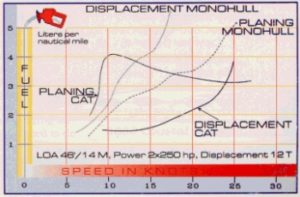
From Malcolm Tennant: Superior Performance of the Displacement Power Catamaran
The bottom line on the graph is what you are after, its hard to read, DC displacement cat.
Fig.1. graphically illustrates the superior performance of the displacement power catamaran. No other configuration gives you the combination of comfort, relatively high speed [very high speed in comparison with a displacement monohull] and long range cruising. The smaller designs; below 16m, can in some cases go Transocean but only at relatively slow speeds because they do not have the capacity to carry enough fuel for longer trips at higher speeds. The larger vessels, from 16m up, can go Transocean at speeds from 15 to 20 knots for two to three thousand miles on their basic inbuilt tankage. This is the sort of performance that had previously only been available in monohull in the 40m+ range. The very low fuel usage that is evidenced in the graph means much lower operating costs. This, combined with the very good seakeeping, and the unprecedented stability which is inherent in the displacement catamaran, introduced a new concept in long range travel at sea. And of course the smaller horsepower requirements for a particular performance reduces your initial capital cost also.
Bridgedeck Clearance for Cats -- Does it matter?
This exerpt has been taken out of Tony Grainger’s design catalogue. “The answer might seem obvious to anyone who has sailed bridgedeck cats offshore, but it isn’t so obvious to the newcomer to multihulls and one could be excused for asking the question when we see the proliferation of production cruising cats with relatively, and sometimes very low bridge clearance.
Excessive clearance will create undesirable windage and it also increases the gap between the boom and the water, which is a major factor in reducing the efficiency of the rig from induced drag. However, it must be remembered that abridge clearance is reduced as heeling takes place and if the clearance is inadequate, safety, comfort, and overall performance will be compromised.
So what does it matter? Wave slamming is most likely to occur upwind when the pitching of the boat interacts with the occasional steeper wave to cause slamming under the bridge. However, slamming can occur on any angle of sail including downwind and is typically experienced on Australia’s East Coast when there is a residual short sharp swell left over from a fresh northeasterly, combined with the more even south easterly swell which is almost always present, even if only small.
The effects can vary from the occasional distraction of a dull thump under the bridge, to constant impacts which will slow the boat, and severely impede progress to windward, and in the extreme will lead to structural damage.
So how much clearance is enough? It depends on the width of the boat (a wider bridge has greater exposed flat area), the degree to which the boat pitches, (subject to hull shapes), and to what extent you value performance (and by implication, safety) as opposed to retaining a low profile However, it could be said that a clearance of much less than 6% or 7% of LOA would be generally considered to be low for an offshore sailing catamaran.
Power Cats and the LCG
From Malcolm Tennant, Professional Boat Builder, April/May 2000:
An overweight multihull with trim problems is not easy to fix. Some keelboat designers and builders take a rather cavalier approach toward mass and longitudinal center of gravity (LCG) calculations. In many ways this is quite understandable. By adding and subtracting ballast, the displacement of most monohulls can be adjusted relatively easily after the vessel is built. (This excludes high-tech boats, such as America’s Cup competitors, which have ballast ratios of around 80% and ballast concentrated in the keel bulb.) The LCG position can be changed by moving the ballast fore-and-aft to affect trim; the keel can be repositioned; and the mast can often be moved-admittedly all a bit drastic and undesirable. But post-hoc solutions to a trim, or an overweight problem, are possible. In fact, these things may often be done so the vessel will achieve a more favorable rating for racing.
What is the minimum size for an ocean-going power catamaran?
Taken from The Power of Multihulls, Spring 2000, by Malcolm Tennant:
“I am often asked “how small” a power catamaran can be and still be used for serious ocean going. This is really a “how long is a piece of string” type of question, but the St. John 44 is a serious attempt to actually answer it.
Can I use a foreign flag vessel in charter service in U.S. waters?
The following discussion is intended to provide general guidance as to issues that may arise for a particular transaction. Such issues are best considered on an individual case basis.
Any foreign vessel entering for navigation between ports in U.S. waters must be imported, requiring payment of an import duty, or must obtain a U.S. Customs cruising permit. The cruising permit does not allow commercial activity while in the U.S., such as charter service.
A foreign flag vessel, which has been imported, is restricted from carrying passengers from one U.S. port to another, or from carrying passengers within U.S. waters without a foreign voyage, because it is not eligible for a coastwise trade license. 46 U S.C. 12106. Only U.S. documented vessels are eligible, and vessels which have been foreign built or foreign owned are excluded from this license. 46 U.S.C. 12106(a)(2); 46 C.F.R. 67.17-5(c). Congressional exemptions may be granted to these requirements, on a case by case basis.
A foreign flag vessel which engages only in foreign voyages, including cruises to nowhere into international waters, would not be in violation of Coast Guard restrictions, though it would have to clear U.S. Customs for each entry and exit. If it is operating as a vessel carrying passengers for hire, there will be inspection requirements which verily compliance with foreign flag state requirements and compliance with U.S. laws.
A foreign flag vessel which has been imported into the U.S. and engages in bare boat charters in U.S. waters must comply with the State requirements for registration and sales tax, and must still clear on every exit and entry from a U.S. port since it is a foreign vessel without a cruising permit.
Insurance?
Based on what experts say, they advise boaters to stop worrying about their insurance and start thinking about how to afford their next boat. Unless you have an arm-length history of claims or are planning to set sail for Tahiti in a ’68 rust bucket with only your significant other as crew, buying insurance shouldn’t be high on your list of worries.
“It’s not about the boat, but the individual. It has to do with individual risk. Obtaining insurance depends on the past experience of the boat owner.”
Powercat Fuel Consumption Comparisons
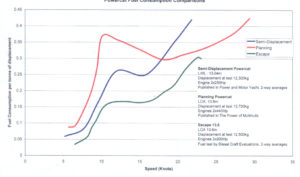
by Malcolm Tennant Multihull Design LTD
Frequently in magazines and on web sites you will find claims of ‘greater speeds’, ‘lower fuel consumption’, ‘longer range’ for a particular design. Here at Malcolm Tennant Design Ltd, we pride ourselves at producing fuel efficient powerboats which give high speeds on displacement hulls with as low as possible horsepower requirements. Our efficient hulls allow for longer ranges with a given amount of fuel.
A Case for Displacement Power Catamarans
Article by Malcolm Tennant as published in Multihulls Magazine
In our Premier Issue, Malcolm Tennant, one of today’s foremost power catamaran designers, discusses the principles of planing vs. displacement catamarans. In this article he makes clear his choice of the displacement cat.
Job Application
Please complete and return to Info@PedigreeCats.com or mail to 1835 Ocean Ave., Raymond, WA 98577.
Thank you!
